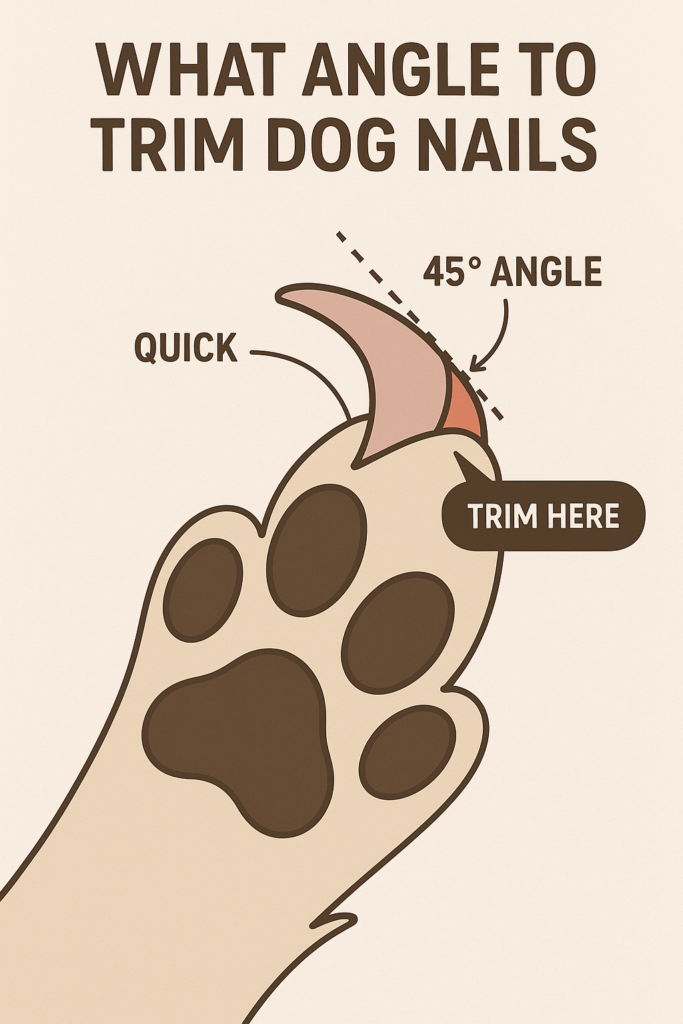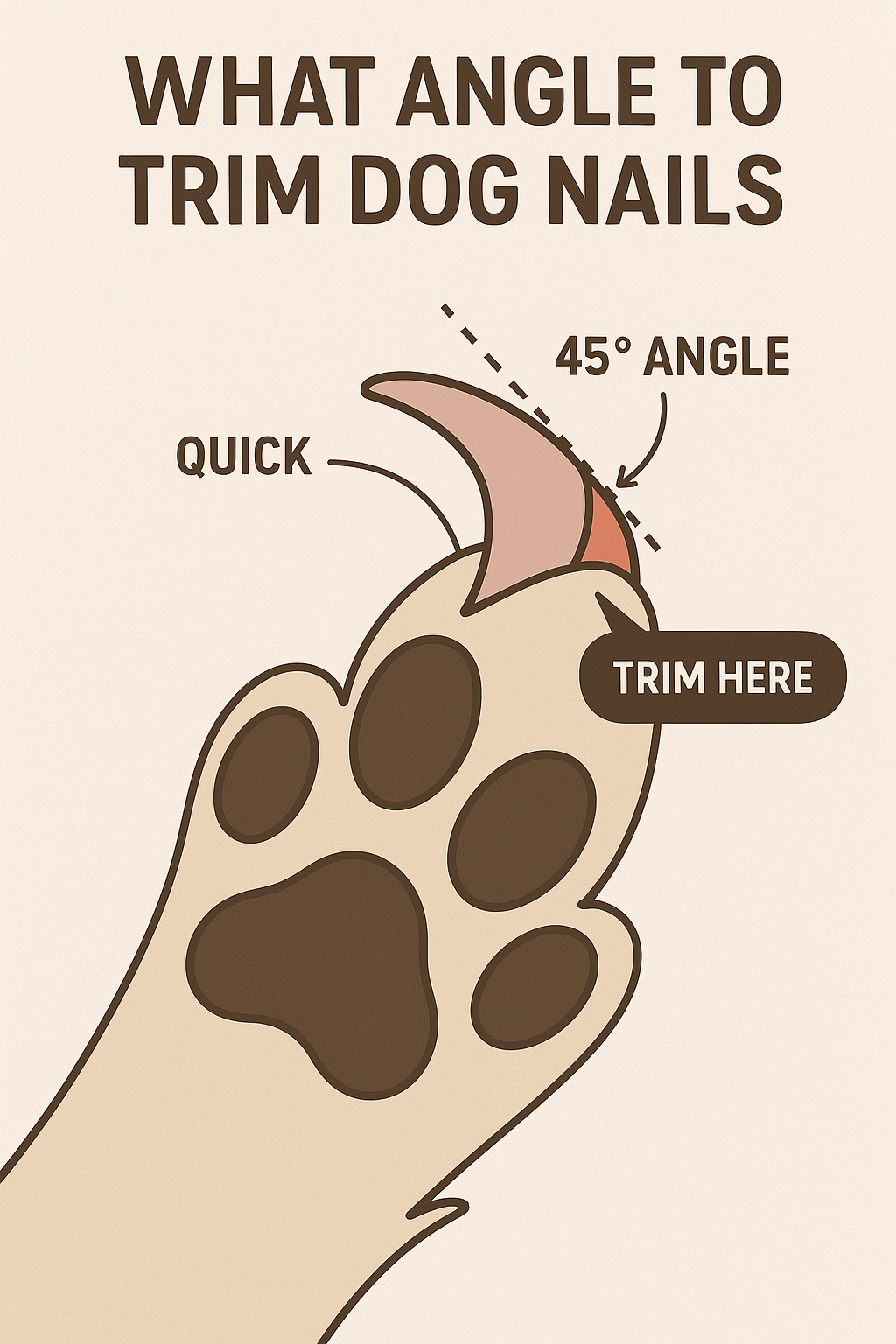What Angle to Trim Dog Nails? A Comprehensive Guide
Trimming your dog’s nails is an essential part of their grooming routine, but it can feel intimidating if you’re unsure about the correct technique. One of the most common questions pet owners ask is, “What angle should I trim my dog’s nails?” The angle at which you cut plays a crucial role in ensuring your dog’s comfort and preventing injury. Whether you’re a first-time nail trimmer or looking to refine your skills, understanding the proper approach is key to keeping your pup’s paws healthy and pain-free. In this guide, we’ll explore expert tips, tools, and techniques to help you master this important task with confidence.
Expert Advice: Avoid Lifting Your Dog’s Leg Too High
“One common mistake Sexton sees dog parents doing is lifting the leg up out of its normal range of motion. To avoid discomfort and even potential injury, she suggests keeping the paw close to the surface your dog is resting on.”
Understanding the Anatomy of Dog Nails
Before diving into the trimming process, it’s important to understand the anatomy of your dog’s nails. This knowledge will help you avoid cutting too close to sensitive areas and ensure a safe trimming experience.
The Quick Inside the Nail:
The quick is the blood vessel and nerve inside the nail. Cutting into it can cause pain and bleeding, so identifying its location is critical.Light vs. Dark Nails:
In dogs with light-colored nails, the quick is visible as a pink area. For dark nails, the quick is harder to see, requiring extra caution during trimming.Curved Shape of Nails:
Dog nails have a natural curve, which means they need to be trimmed at an angle to maintain their shape and function.Outer Shell vs. Inner Core:
The outer shell of the nail is hard, while the inner core contains the quick. Avoid cutting too deeply into the inner section.Wear Patterns in Active Dogs:
Dogs that walk frequently on hard surfaces may naturally wear down their nails, reducing the need for frequent trimming.
Understanding these anatomical details ensures you approach nail trimming with precision and care, minimizing discomfort for your furry friend.

The Ideal Angle for Trimming Dog Nails
Trimming your dog’s nails at the correct angle is essential for maintaining their paw health and mobility. Here’s how to determine the best angle for a safe and effective trim.
Follow the Natural Curve:
Trim along the curve of the nail, avoiding straight cuts that can leave sharp edges or damage the nail structure.Aim for a 45-Degree Angle:
A slight 45-degree angle is often recommended to remove excess length without risking the quick.Focus on the Tip:
Only trim the very tip of the nail, gradually working your way back if necessary. This minimizes the risk of cutting too deeply.Avoid Cutting Flat Across:
Cutting flat across the nail can make it more prone to splitting or cracking, which can be painful for your dog.Adjust for Thick Nails:
For dogs with thicker nails, trim smaller sections at a time to maintain control and precision.
By following these guidelines, you can achieve a clean, safe trim that keeps your dog comfortable and their nails in good condition.
Check this guide 👉Understanding Dog Nail Anatomy: Best 7 Expert Tips!
Check this guide 👉Understanding Dog Nail Cancer: Best 7 Expert Tips!
Check this guide 👉Is a Dog Nail Scratch Dangerous? Best 7 Health Tips!
Tools for Trimming Dog Nails | Tips for Safe Trimming |
|---|---|
Guillotine-style clippers | Always stay calm and confident |
Scissor-style clippers | Use treats to reward your dog |
Electric nail grinders | Trim small sections at a time |
Styptic powder for bleeding | Identify the quick before cutting |
Nail files for smoothing edges | Work in a quiet, distraction-free area |
Signs Your Dog Needs a Nail Trim
Knowing when to trim your dog’s nails is just as important as knowing how to do it. Look out for these signs that indicate it’s time for a trim.
Clicking Sounds on Hard Floors:
If you hear your dog’s nails clicking as they walk, it’s a clear sign their nails are too long.Difficulty Walking or Running:
Overgrown nails can alter your dog’s gait, causing discomfort or even joint problems over time.Snagging on Carpets or Fabric:
Nails that catch on surfaces are not only annoying but also pose a risk of tearing or injury.Visible Curvature of Nails:
If the nails start curving downward toward the paw pad, immediate trimming is necessary.Reluctance to Play or Exercise:
Dogs with overly long nails may avoid activities due to pain or discomfort while moving.
Recognizing these signs ensures you address nail issues promptly, keeping your dog active and happy.
How to Calm a Nervous Dog During Nail Trimming
Many dogs feel anxious about having their nails trimmed, but there are ways to make the experience less stressful. These tips can help soothe your pup and create a positive association with nail care.
Introduce Tools Gradually:
Let your dog sniff and inspect the clippers or grinder before using them. Reward them with treats for curiosity.Start with Paw Handling:
Practice gently touching and holding your dog’s paws during playtime to build trust and reduce sensitivity.Use Positive Reinforcement:
Offer praise, treats, or toys after each successful interaction to reinforce good behavior.Keep Sessions Short:
Limit trimming sessions to just a few nails at a time to prevent overwhelming your dog.Stay Calm Yourself:
Dogs pick up on your emotions—if you’re relaxed, they’re more likely to feel safe and secure.
With patience and consistency, you can turn nail trimming into a stress-free bonding activity for both you and your dog.
Common Mistakes to Avoid When Trimming Dog Nails
Even experienced pet owners can make mistakes when trimming dog nails. Being aware of these common errors helps you avoid accidents and ensure a smooth process.
Cutting Too Close to the Quick:
Accidentally nicking the quick causes pain and bleeding. Always err on the side of caution when trimming.Using Dull or Improper Tools:
Dull clippers can crush the nail instead of cutting cleanly. Invest in high-quality, dog-specific tools.Rushing the Process:
Moving too quickly increases the risk of mistakes. Take your time to assess each nail carefully.Ignoring Signs of Stress:
If your dog shows signs of anxiety, such as growling or pulling away, pause the session and try again later.Skipping Regular Maintenance:
Infrequent trimming leads to overgrown nails, making future trims more challenging. Stick to a consistent schedule.
Avoiding these pitfalls ensures a safer and more comfortable experience for your dog.
Benefits of Regular Nail Trimming
Regularly trimming your dog’s nails offers numerous benefits beyond aesthetics. These advantages highlight why this grooming task is so important.
Improved Mobility:
Properly trimmed nails allow your dog to walk and run comfortably without straining their joints.Reduced Risk of Injury:
Shorter nails are less likely to snag, crack, or break, preventing painful injuries.Enhanced Paw Health:
Trimming prevents nails from growing into the paw pad, which can lead to infections or discomfort.Better Behavior:
Dogs with overgrown nails may act irritable or restless due to discomfort. Regular trims improve their mood and behavior.Protection for Your Home:
Short nails mean less damage to floors, furniture, and carpets caused by scratching or snagging.
These benefits underscore the importance of incorporating nail trimming into your dog’s regular care routine.
Alternatives to Traditional Nail Trimming
If traditional nail trimming proves too difficult, there are alternative methods to keep your dog’s nails in check. These options cater to different needs and preferences.
Electric Nail Grinders:
Grinders file down nails gradually, reducing the risk of cutting too close to the quick.Professional Grooming Services:
Many groomers offer nail trimming as part of their services, providing a stress-free option for nervous dogs.Scratching Boards for Dogs:
Similar to cat scratching posts, these boards allow dogs to naturally file their nails through scratching.Increased Exercise on Hard Surfaces:
Walking your dog frequently on sidewalks or gravel can naturally wear down their nails over time.Nail Caps for Dogs:
Soft caps cover the nails, preventing scratches and damage without altering the nail itself.
Exploring these alternatives ensures you find a solution that works best for your dog’s personality and lifestyle.
Frequently Asked Questions About Trimming Dog Nails
How often should I trim my dog’s nails?
Most dogs need their nails trimmed every 3-4 weeks, depending on their growth rate and activity level.
What if I accidentally cut the quick?
Apply styptic powder or cornstarch to stop the bleeding and soothe the area. Consult your vet if needed.
Can I use human nail clippers on my dog?
No, human clippers are not designed for dog nails and can cause damage. Use dog-specific tools instead.
Do all dogs need their nails trimmed?
While some active dogs naturally wear down their nails, most still require occasional trimming to stay healthy.
How can I tell where the quick is in dark nails?
Trim small sections at a time and look for a gray or pinkish center, which indicates the quick’s location.
Mastering the Art of Dog Nail Trimming
Trimming your dog’s nails doesn’t have to be a daunting task. With the right tools, techniques, and mindset, you can confidently maintain your pup’s paw health while strengthening your bond. Remember, practice makes perfect—whether you’re learning the ideal angle for trimming or calming a nervous dog, patience is key. By staying attentive to your dog’s needs and addressing issues promptly, you’ll ensure their comfort and well-being for years to come. So grab those clippers (or grinder!) and give your furry friend the gift of healthy, happy paws!
Cat Fever Treatment: Best 7 Expert Tips! Discover expert advice on identifying, managing, and treating fever in cats to ensure their quick recovery and well-being.
Understanding Meloxicam for Cats: Best 7 Expert Tips! Learn how to safely administer meloxicam, manage side effects, and ensure your cat's comfort with expert advice on feline pain relief.
Amoxicillin for Cat UTI: Best 7 Expert Tips! Discover safe usage, dosage guidelines, and expert advice on treating feline urinary tract infections effectively with amoxicillin.
Understanding Cat Cancer Treatment: Best 7 Expert Tips! Discover expert advice on managing feline cancer, from early detection to treatment options, ensuring your cat’s health and comfort.





